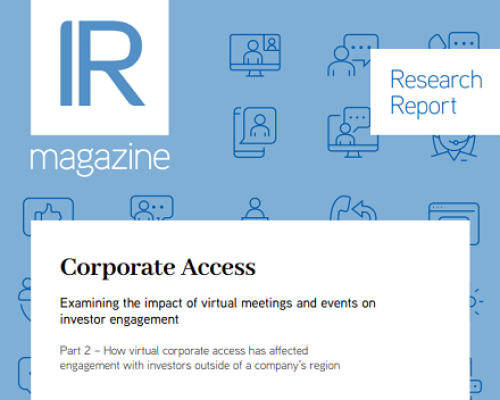Norges Bank, CI Investments and CA Technologies have developed fresh approaches to corporate access
This year, IR Magazine talked to a mutual fund group pushing for direct contact with companies because non-deal roadshows organized by the sell side may be starting to dry up. We also heard from a huge sovereign wealth fund (SWF) that is starting a corporate access team to organize meetings with issuers, though more in the name of frugality and self-reliance than any loss of faith in the sell side.
Other clues had been simmering away: big money managers quietly asking companies to come without their sell-side minders next time, UK financial regulators focusing on payments for corporate access, and an IR conference where Kelsey Turcotte faced down a panel of heavyweight buy-side fund managers and analysts. Give me creative ideas for new ways to meet with you, demanded the straight-talking senior vice president of investor relations from CA Technologies, because the old way doesn’t work anymore.
With stock trading and deal making ebbing more than flowing, the business model for investment banks is in doubt, and both equity research and corporate access are questionable loss leaders, never mind profit drivers. For this article, IR Magazine talked to two investors and one company, all looking for other ways to make contact.
The 800lb elephant in the meeting room
Norges Bank Investment Management, which manages the world’s largest SWF on behalf of Norway, is evolving, even as it sticks to the much-admired bottom-up approach that carried it healthily through the financial crisis. The giant investor is set on becoming more active in its approach to equities management, including taking bigger positions in companies through a new capital strategies department.
While Norges Bank still invests through a number of external money managers running different strategies, these are often small, specialized pools of money. What’s new is that the fund as a whole is building up ‘internal competence,’ says Finn Hvistendahl, global head of sector strategies at Norges Bank. His department consists of around 20 fund managers with industry mandates – many of them global in scope – and only a handful of junior analysts.
‘We’re changing how we do corporate access,’ Hvistendahl states. ‘We still use the sell side quite a lot, but we’re also getting the portfolio managers to set up more of the meetings themselves, and we are starting up our own corporate access team.’
The rationale for cutting down on sell-side organized meetings is plain: the pragmatic Norwegians don’t see the need to rely on a third party to arrange meetings for them in a market like the UK where they already have a sizable presence. ‘But more importantly, we simply want to be more active, so our portfolio managers will reach out more to companies,’ Hvistendahl says.
As well as meeting companies in their offices, Norges Bank’s portfolio managers are encouraged to go out on the road more to see management teams, and to spend less time at conferences, where they risk seeing and hearing the same companies as everyone else. Direct dialogue between companies and Norges Bank is increasing at board level as well. Corporate governance research and engagement were formerly the responsibility of a separate team; now they are being integrated into the portfolio managers’ work.
Bowling for dollars
When Turcotte called in frustration for new ideas for direct interaction with the buy side, she floated the idea of a bowling night (somewhat as a provocation as she is, she says, ‘terrible at bowling’).
‘This is a relationship business, but investor conferences are like speed-dating,’ she says. ‘If good investors are truly interested in what they say they are interested in, which is the quality of management, I don’t know how they can make decisions in 25 to 30-minute blocks.’ She feels non-deal roadshows are only a tad better.
Turcotte once asked an analyst on the West Coast to organize a wine-tasting evening. Instead she got a dinner with wine pairings. ‘It was good but the problem with a big dinner format is the executive can’t breathe, can’t eat, can’t talk, and I’m as interested in the quality of the executives’ experience as I am in the investors’, because I want them to come back and do it again,’ she points out. ‘When someone from the sell side calls me to do some marketing, I try to push him or her to come up with creative ideas that provide an opportunity for long-term relationship building.’
At CA, a $12.5 bn IT company based in New York, Turcotte has had success with deep-dive events for investors that have already done their groundwork. She attracted a good crowd of investors to a customer panel hosted by CA’s head of sales and the next year rolled it into a cocktail party with product demos.
In addition, CA World, a client conference held every 18 months, has an investor track. A product update at CA’s Manhattan headquarters attracted a standing-room-only crowd of 65.
Hedging its biggest bet
‘The sell side’s changing economics have made the notion of using it as your primary conduit for contact with the buy side very challenging,’ pronounces Malcolm White, portfolio manager at Signature Global Asset Management in Toronto, which manages $42 bn in assets and is part of CI Investments, which has total assets of $106 bn.
‘Despite the strength of the markets, in terms of relationships it feels more like 2008, given the level of turnover and downsizing we are seeing on Wall Street. It’s creating chaos – as well as an ever-increasing need to have direct contact with companies.’
White believes this will be a key theme for IROs over the next five to 10 years. The cash equities, or stock trading, business is about half what it was before the 2008 financial crisis. As brokers cut costs, and with travel one of their major expenses, they shifted their focus away from investors outside the major markets of London, New York and Boston, leaving investors like White wondering about the future. ‘We have seen a 10 percent reduction in interactions with the Street year on year,’ he says.
While many investors seem to be chugging along as though the world hasn’t changed, CI is facing the change head-on. ‘Looking out five years from now, we are concerned about the health of the sell side and that we are entirely dependent on it to set up our corporate access,’ White says. ‘So we are looking at ways to hedge this risk by expanding the number of interactions we set up directly.’
White isn’t advocating that IROs abandon the sell side. But he does want them to explore other channels, and he laments that many seem reluctant to come directly to CI without a sell-side go-between. One UK company recently asked him for a meeting when senior management came to Toronto: ‘It came in apologizing for calling me directly. I said, Don’t apologize – it’s refreshing!
Face time, any timeMalcolm White, portfolio manager at Signature Global Asset Management, part of CI Investments, is an early adopter of OpenExchange, a desktop videoconferencing network for financial communications. A big draw is a directory of who’s on the network so he can initiate contact directly. In addition, the software smooths out troublesome technical issues. ‘We don’t have to deal with any technical problems linking external videoconferencing systems,’ he says.After some trial runs, White is ready for broad-scale outreach, hiring a summer student to contact issuers already on OpenExchange to set up video meetings, then inviting others to get set up. A full-time corporate access employee may arrive in the future. He has even created an email address for issuers seeking a meeting: meetsignature@ci.com. ‘There are probably always going to be broker-sponsored non-deal roadshows, but we’re concerned that with budget pressures there will be fewer and fewer,’ White explains. ‘In fact, there has been a marked decline in interactions from year to year. The way we look at it, we need to enhance our mix of interactions. Videoconferencing is a great tool to use to expand our engagement efforts.’ |










